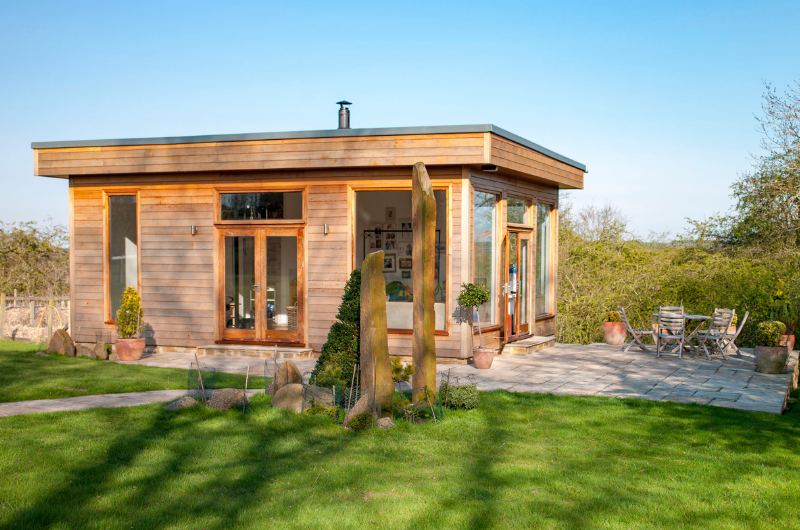As more homeowners invest in garden rooms for work, leisure, or relaxation, making these spaces comfortable year-round has become essential.
Insulation plays a vital role in turning a simple outbuilding into a warm, usable space through all seasons — especially in the UK where weather fluctuations are frequent.
At Underlay4u, we know that floor insulation is one of the most overlooked but important aspects of insulating a garden room.
This guide will walk you through everything you need to know, with a particular focus on the need for underlay and how it supports both comfort and energy efficiency.
Why Insulation Matters in a Garden Room
Unlike main houses, garden rooms are often built with lighter materials and may lack the same depth of insulation in the floors, walls, and roof. As a result, they’re prone to becoming too cold in winter and uncomfortably warm in summer.
Effective insulation helps:
- Retain heat during the colder months
- Reduce noise and echo
- Create a more energy-efficient space
- Make the room usable all year round
While wall and roof insulation are important, heat loss through the floor can be just as significant — and that’s where choosing the right underlay becomes essential.
Understanding Floor Insulation: The Basics
A well-insulated floor does two key things:
- Stops cold air from rising through the floorboards or subfloor.
- Prevents warm air from escaping downward.
Most garden rooms have timber bases or concrete slabs as their foundation. Both types allow heat to escape if not properly insulated — especially when you lay laminate, LVT, vinyl, or carpet directly on top without an insulating barrier.
That’s where underlay makes a difference.
The Role of Underlay in Garden Room Insulation
We often hear the question: Is underlay really necessary in a garden room? Our answer is an emphatic yes — especially if you want to reduce drafts, retain warmth, and increase comfort underfoot.
Here’s how high-quality underlay contributes to insulation:
1. Thermal Insulation
Some underlays are designed with high tog ratings, meaning they offer more resistance to heat flow. The higher the tog, the better the insulation. If you’re laying carpet in your garden room, choosing an underlay with a tog rating of 2.5 or above can make a noticeable difference.
2. Moisture Protection
For timber-based garden rooms, moisture rising from below can be a problem. Many modern underlays come with a built-in damp proof membrane (DPM), preventing dampness from seeping into your flooring and damaging insulation materials.
3. Acoustic Benefits
If your garden room is used as a home office, studio, or entertainment space, underlay also helps reduce sound transmission, making it feel more like an extension of the home.
4. Energy Efficiency
When underlay is used in combination with other forms of insulation (like PIR boards or foil-backed materials), it contributes to lower energy costs and a smaller carbon footprint.
Best Types of Underlay for Garden Rooms
Not all underlays are made equal. For a garden room, you’ll want to choose underlay that prioritises thermal insulation without compromising support or stability.
Here are some of our top recommendations:
PU Foam for Carpets Underlay (High-Tog)
PU foam underlays are made from recycled materials and provide excellent thermal insulation. They’re soft underfoot and ideal for carpeted floors in garden rooms.
- Example: Carpenter Deep Step – with a tog rating of over 3.0
- Best for: Carpeted flooring
Thermal Underlay for Laminate or Wood Flooring
If you’re laying laminate or engineered wood, go for a dense foam or rubber underlay with a foil backing to reflect heat back into the room.
- Example: Duralay Heatflow Laminate Underlay with foil and DPM
- Best for: Laminate, wood, or LVT floors
Step-by-Step: How to Insulate the Floor in Your Garden Room
If you’re planning to insulate your garden room yourself, here’s a step-by-step overview of how to approach the flooring:
Step 1: Assess the Subfloor
Is it a timber frame with joists and boards, or a concrete base? This will determine whether you need additional rigid insulation (like PIR boards) before laying your underlay.
- Timber subfloors: Often benefit from insulation between the joists before the final floor and underlay go down.
- Concrete bases: May require a damp-proof membrane layer, then underlay on top.
🔨 Step 2: Add Rigid Insulation (Optional)
For colder garden rooms, adding a layer of rigid insulation boards (such as Celotex or Kingspan) can significantly improve thermal resistance.
- Cut boards to size and fit snugly between floor joists or lay flat on the base.
- Seal gaps with foil tape to reduce heat loss.
🔨 Step 3: Lay a Damp-Proof Membrane (If Needed)
This is especially important if your garden room is on a concrete slab, where moisture can rise and damage your flooring or insulation.
Some underlays include a built-in DPM, which saves time and effort.
🔨 Step 4: Roll Out the Underlay
Choose your underlay based on your chosen flooring type. Ensure it covers the entire floor area with minimal gaps. Tape the seams where necessary.
- For carpets: high-tog PU foam is ideal
- For laminate: use foil-backed underlay with moisture protection
🔨 Step 5: Install the Flooring
Once your underlay is down, you can lay your chosen flooring — whether that’s carpet, laminate, LVT, or engineered wood.
Properly installed underlay will:
- Improve comfort underfoot
- Reduce noise
- Retain heat
- Protect your flooring from damage
Common Mistakes to Avoid
When insulating a garden room floor, we often see homeowners make a few key errors. Here are some to avoid:
- Using standard domestic underlay that offers little to no insulation
- Skipping the DPM on a concrete base
- Overlooking insulation between joists in timber builds
- Laying laminate without acoustic or thermal underlay
- Using carpet underlay beneath vinyl or LVT (can cause shifting or damage)
If you’re unsure, we’re always here to offer advice based on your exact setup.
Ultimately, Don’t Overlook the Insulationn
When it comes to garden room insulation, the floor is often underestimated — but it plays a major role in the year-round usability of the space. The right underlay not only provides thermal insulation but also offers moisture resistance, noise control, and flooring protection.
At Underlay4u, we stock a wide range of high-performance underlays suitable for all garden room floor types. Whether you’re going for a cosy carpet feel or a sleek laminate finish, there’s an insulating solution that fits your needs.



